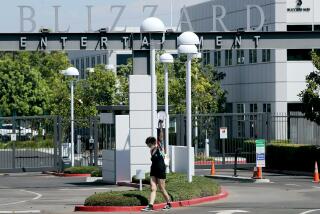Cutback at JPL Worries City, Many Workers : Space: Some supervisors say downsizing is just one of the inevitable drops in the aerospace industry. Only one project is in the works.
PASADENA — Workers at the Jet Propulsion Laboratory say that even though last week’s announcement that the space research center will cut its work force by 1,000 in the next five years was long expected, it has intensified the anxiety level in offices and laboratories.
*
“I’ve had three employees coming in today asking, ‘What does this mean?’ ” said the head of one research group, who asked not to be named. “They want to know if they have to worry about their jobs.”
The announcement also troubled city and business leaders.
The move is worrisome, said Pasadena City Manager Philip Hawkey. He said city officials are already preparing initiatives to attract more engineering and biotechnology firms to Pasadena. “You never want to see 1,000 jobs lost,” said developer Lary Mielke, president-elect of the Pasadena Chamber of Commerce. “Hopefully, we’ll be able to find four or five new businesses to come into Pasadena and soak up those jobs. We need to replace (the losses) with some growth.”
*
The cancellation last year of a JPL program to send a spacecraft to the asteroid belt and Comet Kopff, as well as the continuing difficulties of the aerospace industry, helped prepare some workers for the announcement.
“It’s not surprising,” a JPL engineer said. “There’s nothing really big planned for JPL right now.”
The 176-acre campus that once simmered with big space projects in various planning stages now has only one in the works: the Cassini project, a space probe to the planet Saturn, scheduled for liftoff in October, 1997. Others have either already been launched or canceled.
Some supervisors sought to assure workers that the downsizing was just one of the inevitable drops in the aerospace business. “In any industry, things shrink and grow,” one researcher said. “I don’t think it’s any different at JPL.”
JPL Director Edward C. Stone said in a memorandum to the space lab’s 7,500 employees Thursday that the realities of the federal budget and the physical limitations of JPL’s campus in Pasadena and La Canada Flintridge dictated the downsizing of the center.
Like the National Aeronautics and Space Administration, JPL’s primary client, the research center has been getting a shrinking share of federal research dollars in recent years, Deputy Director Larry Dumas said. JPL’s budget this year is $1.05 billion, down from a peak five years ago of about $1.3 billion.
Dumas described the new austerity program as “a sort of general belt-tightening across the lab.”
Because of increasing staff levels during the go-go years, JPL has spread out into adjoining communities, and the program spends about $6 million a year to lease office and laboratory space in Pasadena and Altadena.
JPL plans to close the Foothill Complex, an accounting unit in five Pasadena office buildings, and the Sierra Madre Villa facility, which houses an information systems division and the Voyager Project. The Voyager is JPL’s 16-year-old unmanned spacecraft probe of the outer edges of the solar system.
Shutting those facilities will save JPL more than $3.5 million a year, Dumas said. The programs housed in them will be relocated to the main campus, Dumas said.
Most of the staff reductions will take place through attrition, Dumas said, but there will be some layoffs. About 75 positions have been eliminated since the beginning of the federal fiscal year in October, he said.
The Stone memorandum said that “we will do our best to provide relocation services for those affected.”
Some of those whose jobs were eliminated are expected to find work elsewhere within the program, Dumas said.
The shrinkage does not necessarily mean a reduction in JPL programs, Dumas added. JPL contracts most of its production work to private industry, he said, and even more of the work will now go to Southern California’s beleaguered aerospace firms.
“Though you see the JPL name and logo on a spacecraft,” Dumas said, “at least two-thirds of the content has been provided by industry. Now, we’re shifting a bit more in favor of industry.”
The research director said Stone’s announcement had needlessly worried her employees. “JPL management has known this was happening for months,” she said.
“What it really means is that if I want to interview somebody for a job, I have to get another level of approval. But does it keep me from getting my work done? No. Does it mean we’re laying off valuable employees? No.”
More to Read
Inside the business of entertainment
The Wide Shot brings you news, analysis and insights on everything from streaming wars to production — and what it all means for the future.
You may occasionally receive promotional content from the Los Angeles Times.










